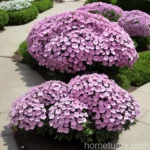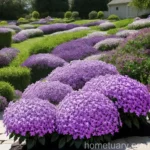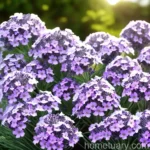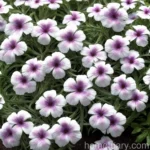Garden Phlox (Phlox paniculata ‘Jeana’)
Phlox paniculata, commonly known as garden phlox, is a stunning perennial flower known for its vibrant colors and ability to attract pollinators such as butterflies and hummingbirds. One popular cultivar of Phlox paniculata is ‘Jeana’, which is celebrated for its delicate pink flowers and hardy nature. In this comprehensive guide, we will delve into the culture, uses, and care of Phlox paniculata ‘Jeana’, providing valuable insights for both novice and experienced gardeners.
What is Garden Phlox (Phlox paniculata ‘Jeana’)?
Garden Phlox, or Phlox paniculata, is a flowering plant in the Phlox family, Polemoniaceae. It is native to the eastern United States and has been a cherished addition to gardens for centuries due to its attractive blooms and fragrant nature. ‘Jeana’ is a specific cultivar of Phlox paniculata, known for its exceptional beauty and resilience.
Key Takeaways – Garden Phlox (Phlox paniculata ‘Jeana’)
Before we dive into the details of garden phlox (Phlox paniculata ‘Jeana’), let’s glance at the key takeaways:
- Phlox paniculata ‘Jeana’ is a stunning perennial plant that adds vibrant colors to gardens.
- It is a favorite among pollinators like butterflies and hummingbirds.
- ‘Jeana’ is cherished for its delicate pink flowers and hardy nature.
Now, let’s explore the culture, uses, and care guidelines for Phlox paniculata ‘Jeana’ in greater detail.
Culture of Phlox paniculata ‘Jeana’
Water
Garden phlox, including ‘Jeana’, thrives in moist but well-drained soil. It is crucial to ensure that the plant receives adequate water, especially during dry spells or when grown in containers. However, it’s essential to avoid overwatering, as waterlogged soil can lead to root rot and other issues.
Sunlight
Phlox paniculata ‘Jeana’ flourishes in full sun to partial shade. When planted in full sun, it tends to produce more abundant blooms, but it can also tolerate some shade, particularly in hot climates.
Soil
The ideal soil for ‘Jeana’ garden phlox is rich, fertile, and slightly acidic to neutral. It should have good drainage to prevent waterlogging. Amending the soil with organic matter such as compost can enhance its texture and fertility, promoting healthy growth.
Fertilizer
Fertilizing garden phlox ‘Jeana’ can help promote vigorous growth and abundant flowering. A balanced, all-purpose fertilizer can be applied in spring, following the manufacturer’s recommendations. It’s crucial to avoid excessive fertilization, as this can lead to lush foliage at the expense of prolific blooming.
Uses of Phlox paniculata ‘Jeana’
Ornamental Value
One of the primary uses of Phlox paniculata ‘Jeana’ is its ornamental value. The delicate pink flowers add a touch of elegance to gardens and landscapes, and they are often used in mixed borders, cottage gardens, and naturalistic settings. With their attractive blooms and fragrance, ‘Jeana’ garden phlox can serve as a focal point or contribute to a diverse planting scheme.
Pollinator Attraction
‘Jeana’ is an excellent choice for gardeners aiming to attract pollinators. The nectar-rich blooms of garden phlox appeal to butterflies, hummingbirds, and other beneficial insects, making it a valuable addition to wildlife-friendly gardens.
Pruning Phlox paniculata ‘Jeana’
Deadheading
Deadheading, or the removal of spent flowers, can prolong the blooming period of Phlox paniculata ‘Jeana’ and promote the development of new blooms. As the flowers fade, they can be snipped off to encourage continuous flowering.
Cutting Back
In late fall or early spring, cutting back the stems of ‘Jeana’ garden phlox to a few inches above the ground can help rejuvenate the plant and maintain its vigor. This practice also eliminates old growth and reduces the likelihood of disease.
Propagation of ‘Jeana’ Garden Phlox
Division
Dividing established clumps of ‘Jeana’ garden phlox every few years can help rejuvenate the plant, prevent overcrowding, and enhance its overall vigor. The process involves digging up the plant, separating the root clumps, and replanting them in suitable locations.
Stem Cuttings
Phlox paniculata ‘Jeana’ can also be propagated through stem cuttings. Softwood cuttings can be taken in late spring or early summer and rooted in a suitable growing medium to produce new plants.
Growing ‘Jeana’ Garden Phlox in Containers
‘Jeana’ garden phlox can also thrive in containers, bringing its beauty to patios, balconies, and small outdoor spaces. When growing in containers, it’s essential to choose a well-draining potting mix and provide regular watering and fertilization to support the plant’s growth and blooming.
Popularity of Phlox paniculata ‘Jeana’
‘Jeana’ garden phlox has garnered popularity among gardeners and landscapers for several reasons:
- Its delicate pink flowers and graceful habit make it a captivating addition to gardens.
- The plant’s ability to attract pollinators contributes to its desirability among wildlife enthusiasts.
- ‘Jeana’ is known for its hardiness and adaptability, thriving in a range of climatic conditions.
Common Diseases of Garden Phlox and Disease Diagnosis
While garden phlox, including ‘Jeana’, is generally resilient, it can be susceptible to certain diseases. Here are some common diseases that may affect Phlox paniculata and tips for diagnosis:
Powdery Mildew
Powdery mildew is a prevalent fungal disease that can affect the foliage of garden phlox, particularly in humid conditions. Symptoms include the presence of powdery, white patches on the leaves, which can hinder photosynthesis and weaken the plant.
Diagnosis
Diagnosing powdery mildew involves inspecting the foliage for the characteristic white powdery coating. As the disease progresses, the affected leaves may become distorted or yellowed.
Prevention and Management
To prevent powdery mildew, ensure proper air circulation around the plants, and avoid overhead watering, which can promote fungal growth. Additionally, applying fungicidal sprays or treatments at the first sign of infection can help manage the disease.
Leaf Spot
Leaf spot diseases, caused by various fungal pathogens, can lead to the development of dark, necrotic spots on the leaves of garden phlox. If left unchecked, severe leaf spot infections can defoliate the plant and weaken its overall health.
Diagnosis
Diagnosing leaf spot diseases involves observing the presence of dark, irregular spots on the foliage, often accompanied by yellowing or browning of the affected areas.
Prevention and Management
To mitigate leaf spot diseases, practice good sanitation by removing and disposing of infected plant debris. It is also helpful to avoid overhead watering and apply fungicidal treatments as a preventive measure.
Common Pests Affecting Garden Phlox
While garden phlox is generally resistant to pest infestations, certain insects may pose potential threats to the plant. Here are some common pests that gardeners should be aware of:
Spider Mites
Spider mites are tiny arachnids that can infest the foliage of garden phlox, causing stippling, discoloration, and the development of fine webbing on the undersides of leaves.
Aphids
Aphids are small, sap-sucking insects that may feed on the tender shoots and new growth of garden phlox. Their presence can lead to distorted growth and the secretion of honeydew, which can attract sooty mold.
Preventing and Managing Pest Infestations
To deter pest infestations, regularly inspect the foliage of garden phlox for any signs of insect activity. Encouraging natural predators such as ladybugs and lacewings can help keep pest populations in check. In cases of severe infestations, targeted insecticidal treatments may be necessary.
Botanist’s Tips for ‘Jeana’ Garden Phlox Care
To ensure the successful cultivation of Phlox paniculata ‘Jeana’, here are some valuable tips from botanists and experienced gardeners:
- Provide consistent moisture, especially during the plant’s establishment and flowering periods.
- Opt for well-draining soil to prevent waterlogged conditions, which can be detrimental to the plant’s health.
- Deadhead spent flowers to encourage continued blooming and maintain the plant’s vitality.
- Regularly monitor the plant for signs of diseases and pests, addressing any issues promptly to prevent escalation.
Fun Facts about Phlox paniculata ‘Jeana’
- The specific epithet “paniculata” in the plant’s botanical name refers to the arrangement of its flower clusters, which form dense, pyramidal panicles.
- ‘Jeana’ garden phlox was discovered growing alongside a railroad in Lexington, Kentucky, indicating its adaptability to diverse environmental conditions.
Links to External Resources
For further information on the care and cultivation of Phlox paniculata ‘Jeana’, consider exploring the following resources:
In conclusion, Garden Phlox (Phlox paniculata ‘Jeana’) stands out as a captivating and versatile perennial plant that can enrich any garden or landscape. With its graceful appearance, alluring fragrance, and ecological benefits, ‘Jeana’ garden phlox is a valuable addition to diverse gardening endeavors.
References
- Jelitto, M., Schacht, P., & Eiber, S. (2011). Hardy perennials and old-fashioned flowers. Timber Press.
- Armitage, A. M. (2001). Armitage’s manual of annuals, biennials, and half-hardy perennials. Timber Press.















